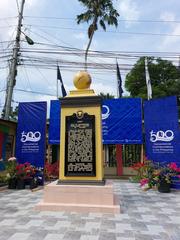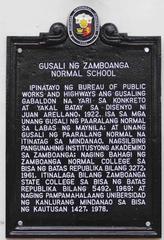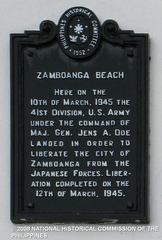Edwin Andrews Air Base: Visiting Hours, Tickets, and Comprehensive Travel Guide to Zamboanga City Historical Sites
Date: 04/07/2025
Introduction: The Historical and Strategic Significance of Edwin Andrews Air Base
Edwin Andrews Air Base (EAAB) is a prominent military installation situated at the heart of Zamboanga City, Mindanao, Philippines. With roots dating back to World War II, the base has played a pivotal role in regional defense, humanitarian missions, and the development of Zamboanga as a strategic gateway to Western Mindanao and the Sulu Archipelago. Initially constructed as San Roque Airfield and later expanded by U.S. forces as Moret Field, the facility was renamed in honor of General Edwin Andrews, the first post-war Filipino Philippine Air Force Commander, in 1956. Today, EAAB remains a cornerstone of the Philippine Air Force’s operations, a hub for international cooperation, and a symbol of Zamboanga’s resilience and multicultural identity.
While EAAB is primarily a restricted military facility, its proximity to cultural landmarks, such as Fort Pilar, Zamboanga City Hall, and Great Santa Cruz Island, makes it a focal point for history enthusiasts and travelers interested in the Philippines’ military heritage. This guide provides an in-depth look at the air base’s origins, military and humanitarian roles, visitor information, travel tips, and nearby attractions, offering a comprehensive resource for anyone planning a visit or seeking to learn more about this iconic installation.
For further details, refer to sources such as Everything Explained Today, Trek Zone, and the Philippine Air Force Official Website.
Origins and Development of Edwin Andrews Air Base
EAAB’s history began during World War II, when it was constructed by the Japanese Imperial Army as San Roque Airfield. Following the liberation of the Philippines, American and Filipino forces expanded and realigned the facility, renaming it Moret Field. In 1956, the Philippine government officially designated the site as Edwin Andrews Air Base to honor General Edwin Andrews. Since then, the base has evolved into one of the most strategically important air installations in the country, supporting both military and civilian operations through its shared runway with Zamboanga International Airport (Everything Explained Today).
Military Significance and International Cooperation
Edwin Andrews Air Base is a vital hub for the Philippine Air Force, home to the 530th Air Base Wing and the 25th Composite Attack Squadron. Its runway, stretching 2,611 meters (8,566 feet), facilitates rapid deployment, counterinsurgency operations, and joint military exercises, particularly in collaboration with the United States. Since 2002, the base has hosted U.S. special forces for counterterrorism initiatives, enhancing interoperability and leading to infrastructure upgrades and advanced technological capabilities (Everything Explained Today).
Humanitarian and Civilian Functions
Beyond its defense role, EAAB is integral to disaster response, humanitarian assistance, and evacuation efforts throughout Mindanao and the Sulu Archipelago. Its proximity to Zamboanga International Airport allows for swift mobilization of relief goods and medical teams during emergencies, reinforcing its importance in both military and civilian contexts (Everything Explained Today).
Visitor Information: Access, Hours, and Security Protocols
Access and Entry Requirements
As an active military installation, EAAB enforces strict access controls. Public entry is generally limited to individuals with official business, scheduled recruitment activities, or special events. Prospective visitors must present valid government-issued identification and any required documentation. Security measures include vehicle inspections and restrictions on photography, except where specifically authorized (Placedigger PH).
Visiting Hours and Tickets
EAAB does not maintain regular public visiting hours or ticketing for tours. Access is generally available during special commemorative events, military ceremonies, or recruitment examinations, all of which require advance coordination with the base’s Public Affairs Office or the Philippine Air Force (Philippine Air Force Official Website). Most events are free, but may require pre-registration.
Recruitment and Examination Venue
The base regularly serves as a venue for the Philippine Air Force Entrance Examination for officers and enlisted personnel. For 2025, application and examination schedules are published online, and all applicants must fulfill eligibility and documentation requirements (Topnotcher.ph; NewsToGov).
Location, Directions, and Transportation
EAAB is located in Barangay Sta. Maria, Zamboanga City, at 6°55’30”N, 122°3’40”E, and is easily accessible from the city center by jeepney, tricycle, or private vehicle. The base is adjacent to Zamboanga International Airport, making it convenient for visitors arriving by air (Trek Zone).
Nearby Historical Sites and Attractions
While the base itself is not open for general tourism, several notable sites nearby enrich the visitor experience:
- Fort Pilar: A 17th-century Spanish fortress and National Cultural Treasure.
- Zamboanga City Hall: An American colonial-era government building.
- Great Santa Cruz Island: Renowned for its unique pink sand beaches.
- Pasonanca Park: Features gardens, a butterfly sanctuary, and historical markers (Trek Zone).
- Joaquin F. Enriquez Memorial Sports Complex: A major sports venue and community gathering space.
Combine your visit to EAAB with these cultural and historical landmarks for a fuller Zamboanga City experience.
Photography and Guided Tours
Photography within EAAB is generally prohibited without explicit authorization. Exterior photos from public areas, such as the perimeter or golf club, are permitted. No regular public guided tours are offered, but special events occasionally provide limited access and educational programs (Philippine Air Force Official Website).
Safety, Security, and Cultural Considerations
EAAB maintains robust security protocols in light of its strategic importance. Visitors must comply with all instructions from security personnel and are expected to dress modestly and behave respectfully, especially during official events. Zamboanga City is generally safe, but travelers should remain vigilant and observe local advisories.
Educational and Community Engagement
The base hosts educational programs, civic activities, and commemorative events—such as the Philippine Air Force Foundation Day and the Day of Valor—offering opportunities for learning and cultural exchange. Outreach initiatives and partnerships with schools foster civic consciousness and national pride (PAF News; Zamboanga Hermosa Festival).
Travel and Practical Tips
- Identification: Always bring government-issued IDs and required documents.
- Arrive Early: Allow time for security checks, especially for recruitment or special events.
- Weather: Zamboanga’s tropical climate warrants sun protection and rain gear.
- Transport: Use reputable taxis or arrange private transportation for convenience.
- Accommodation: Choose hotels or guesthouses in the city center; there is no public lodging on the base.
- Language: Filipino, English, and Chavacano are widely spoken. Using basic Chavacano greetings is appreciated (Chavacano Language Guide).
Frequently Asked Questions (FAQs)
Q: What are the visiting hours for Edwin Andrews Air Base?
A: There are no regular public visiting hours; access is limited to official business, recruitment, or pre-arranged events.
Q: Are tickets or entrance fees required?
A: No tickets are needed for general visits, as public access is restricted. Special events may require pre-registration.
Q: Can I take photographs inside EAAB?
A: Photography is prohibited inside the base without permission, but allowed from public areas outside.
Q: How do I arrange a visit or guided tour?
A: Contact the base’s Public Affairs Office or check the Philippine Air Force Official Website for announcements.
Q: What other historical sites are near the base?
A: Fort Pilar, Zamboanga City Hall, Pasonanca Park, and Great Santa Cruz Island are all within easy reach.
Conclusion
Edwin Andrews Air Base is a testament to the Philippines’ enduring military heritage and the vibrant cultural tapestry of Zamboanga City. While general access is limited due to its military function, the base’s influence is felt throughout the community—contributing to local development, disaster response, and national defense. For those interested in Philippine history or military affairs, a trip to the vicinity of EAAB, combined with visits to Zamboanga’s historical landmarks, offers a meaningful and educational experience.
Stay informed about recruitment, events, and travel advisories through official sources, and consider downloading the Audiala app for curated guides and real-time updates on Zamboanga City and beyond.
Sources and Official Links
- Everything Explained Today: Edwin Andrews Air Base
- Trek Zone: Camp General Basilio Navarro
- Trek Zone: Edwin Andrews Air Base
- Philippine Air Force Official Website
- Topnotcher.ph: Philippine Air Force Exam Schedule & Venue
- NewsToGov: Philippine Air Force Exam Schedule & Requirements
- Placedigger PH: Edwin Andrews Air Base
- PAF News
- Zamboanga Hermosa Festival
- Chavacano Language Guide
- National Museum Zamboanga
- Mapcarta: Pasonanca Barangay Hall




